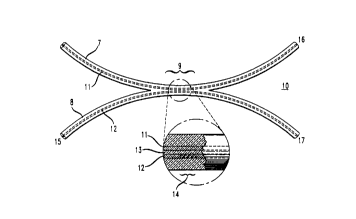Some of the information on this Web page has been provided by external sources. The Government of Canada is not responsible for the accuracy, reliability or currency of the information supplied by external sources. Users wishing to rely upon this information should consult directly with the source of the information. Content provided by external sources is not subject to official languages, privacy and accessibility requirements.
Any discrepancies in the text and image of the Claims and Abstract are due to differing posting times. Text of the Claims and Abstract are posted:
| (12) Patent: | (11) CA 2168902 |
|---|---|
| (54) English Title: | OPTICAL TAPPING FILTERS EMPLOYING LONG PERIOD GRATINGS |
| (54) French Title: | FILTRE OPTIQUE A RESEAU DE DIFFRACTION |
| Status: | Deemed expired |
| (51) International Patent Classification (IPC): |
|
|---|---|
| (72) Inventors : |
|
| (73) Owners : |
|
| (71) Applicants : | |
| (74) Agent: | KIRBY EADES GALE BAKER |
| (74) Associate agent: | |
| (45) Issued: | 1999-03-30 |
| (22) Filed Date: | 1996-02-06 |
| (41) Open to Public Inspection: | 1996-08-25 |
| Examination requested: | 1996-02-06 |
| Availability of licence: | N/A |
| (25) Language of filing: | English |
| Patent Cooperation Treaty (PCT): | No |
|---|
| (30) Application Priority Data: | ||||||
|---|---|---|---|---|---|---|
|
An optical filter comprises a plurality of optical fibers having a coupling
region where the axially extending cores are closely spaced within a common
cladding. The coupling region includes a long period grating for selectively shifting
light of selected wavelengths from guided modes into non-guided modes. These
non-guided modes are picked up by an adjacent core and light of the selected
wavelengths is thus shifted from one core to another. The result is an optical filter
particularly useful as a demultiplexer or a tapping device. In one embodiment the
grating is formed in one of the cores. In an alternative embodiment, it is formed in
the common cladding.
L'invention est un filtre optique comportant une pluralité de fibres optiques ayant une région de couplage où les âmes axiales sont rapprochées les unes des autres et entourées d'une gaine commune. La région de couplage comprend un réseau à période longue servant à faire passer la lumière à certaines longueurs d'onde particulières d'un mode de propagation guidée à un mode de propagation non guidée. La lumière en propagation non guidée est recueillie par une âme adjacente et la lumière aux longueurs d'onde particulières sélectionnées passe donc d'une âme à une autre. On obtient ainsi un filtre optique particulièrement utile comme démultiplexeur ou dispositif de dérivation. Dans l'une des concrétisations de l'invention, le réseau est formé dans l'une des âmes. Dans une autre concrétisation, il est formé dans la gaine commune.
Note: Claims are shown in the official language in which they were submitted.
Note: Descriptions are shown in the official language in which they were submitted.

For a clearer understanding of the status of the application/patent presented on this page, the site Disclaimer , as well as the definitions for Patent , Administrative Status , Maintenance Fee and Payment History should be consulted.
| Title | Date |
|---|---|
| Forecasted Issue Date | 1999-03-30 |
| (22) Filed | 1996-02-06 |
| Examination Requested | 1996-02-06 |
| (41) Open to Public Inspection | 1996-08-25 |
| (45) Issued | 1999-03-30 |
| Deemed Expired | 2003-02-06 |
There is no abandonment history.
| Fee Type | Anniversary Year | Due Date | Amount Paid | Paid Date |
|---|---|---|---|---|
| Application Fee | $0.00 | 1996-02-06 | ||
| Registration of a document - section 124 | $0.00 | 1996-08-01 | ||
| Maintenance Fee - Application - New Act | 2 | 1998-02-06 | $100.00 | 1998-01-06 |
| Final Fee | $300.00 | 1998-12-15 | ||
| Maintenance Fee - Application - New Act | 3 | 1999-02-08 | $100.00 | 1998-12-30 |
| Maintenance Fee - Patent - New Act | 4 | 2000-02-07 | $100.00 | 1999-12-20 |
| Maintenance Fee - Patent - New Act | 5 | 2001-02-06 | $150.00 | 2000-12-14 |
Note: Records showing the ownership history in alphabetical order.
| Current Owners on Record |
|---|
| AT&T IPM CORP. |
| Past Owners on Record |
|---|
| VENGSARKAR, ASHISH MADHUKAR |
| WALKER, KENNETH LEE |